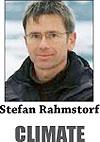All weather is driven by energy, and the sun ultimately provides this energy. But the biggest change in Earth’s energy budget by far over the past hundred years is due to the accumulation in our atmosphere of greenhouse gases, which limit the exit of heat into space.


All weather is driven by energy, and the sun ultimately provides this energy. But the biggest change in Earth’s energy budget by far over the past hundred years is due to the accumulation in our atmosphere of greenhouse gases, which limit the exit of heat into space.
Owing to fossil-fuel emissions, there is now one-third more carbon dioxide in the atmosphere than at any time in at least a million years, as the latest ice drilling in Antarctica has revealed.
The changes in the planet’s energy budget caused by solar variations are at least ten times smaller in comparison. And they go in the wrong direction: in recent years, the sun has been at its dimmest since satellite measurements began in the 1970’s.
So, when unprecedented extreme weather events occur, the prime suspect is naturally the biggest atmospheric change that has happened over the past hundred years – one that has been caused by human emissions.
The fact that heat waves like the one in Russia become more frequent and extreme in a warmer world is easy to understand. Extreme rainfall events will also become more frequent and intense in a warmer climate, owing to another simple fact of physics: warm air can hold more moisture. For each degree Celsius of warming, 7% more water is available to rain down from saturated air masses. Drought risk also increases with warming: even where rainfall does not decline, increased evaporation dries out the soils.
The carbon-dioxide effect can also change the preferred patterns of atmospheric circulation, which can exacerbate extremes of heat, drought, or rainfall in some regions, while reducing them in others.
The problem is that a reduction in those extremes to which we are already well-adapted provides only modest benefits, whereas the new extremes to which we are not adapted can be devastating, as recent events in Pakistan show.
The events of this summer show how vulnerable our societies are to weather-related extremes. But what we see now is happening after only 0.8º Celsius of global warming. With swift and decisive action, we can still limit global warming to a total of 2º Celsius or a bit less.
Even that much warming would require a massive effort to adapt to weather extremes and rising sea levels, which needs to start now.
With weak action, like that promised by governments in Copenhagen last December, we will be on course for 3-4º Celsius of global warming. This is bound to outstrip the ability of many societies and ecosystems to adapt. And, with no action at all, the planet could even heat up by 5-7º Celsius by the end of this century – and more thereafter. Knowingly marching down that road would be insane.
We must face the facts: our emissions of greenhouse gases probably are at least partly to blame for this summer of extremes.
Clinging to the hope that it is all chance, and all natural, seems naive. Let us hope that this summer of extremes is a last-minute wake-up call to policy makers, the corporate world, and citizens alike.
Stefan Rahmstorf is Professor of Physics of the Oceans at Potsdam University
Copyright: Project Syndicate, 2010.


